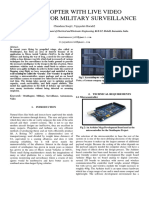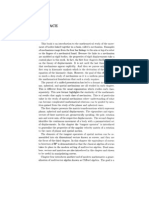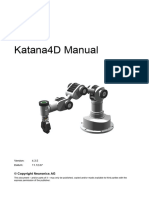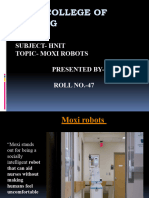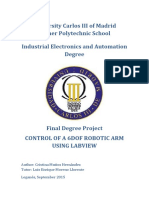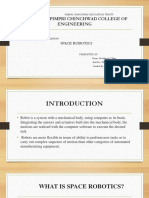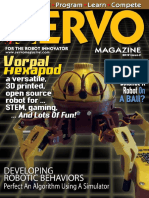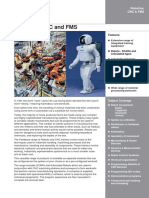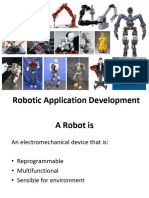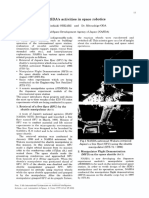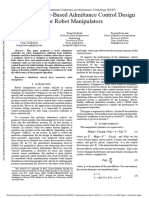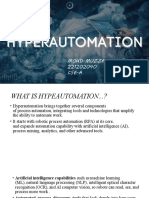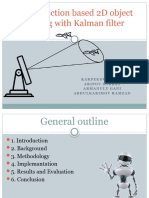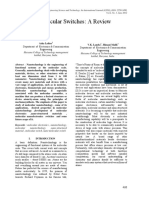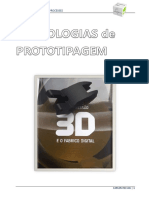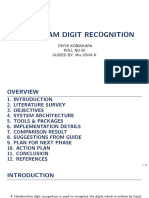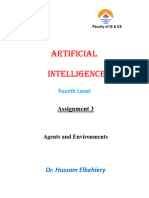Behavior-Based Robotics
Companion slides for the book Bio-Inspired Artificial Intelligence: Theories, Methods, and Technologies by Dario Floreano and Claudio Mattiussi, MIT Press
�A.I. Robotics
In traditional Artificial Intelligence robot brains are serial processing units.
task execution motor control
perception
modeling
planning
sensors
actuators
The keystone ideas behind this approach are: Representations, Reasoning, Planning Model Building (for example, geometric maps) Functional Decomposition, Hierarchical systems Symbol manipulation
Companion slides for the book Bio-Inspired Artificial Intelligence: Theories, Methods, and Technologies by Dario Floreano and Claudio Mattiussi, MIT Press
�Behavior-Based Robotics (Brooks, 1996)
The Behavior-Based approach states that intelligence is the result of the interaction among an asynchronous set of behaviors and the environment.
manipulate the world sensors build maps explore avoid hitting things locomote S R S S S R R R S S R actuators S R
The keystone ideas behind this approach are: Embodiment Situatedness Emergent complexity No planning
Companion slides for the book Bio-Inspired Artificial Intelligence: Theories, Methods, and Technologies by Dario Floreano and Claudio Mattiussi, MIT Press
�A Paradigm Shift
Artificial Intelligence Information processing Cartesian thinking
Thinking and reasoning Seat of intelligence: brain
Acting and behaving Seat of intelligence: organism Artificial Life Sensory-motor coordination Agent-centered; action based
Behavior-Based paradigm affects both software and hardware design
Ghenghis, 1985, MIT Shakey, 1970, Stanford Companion slides for the book Bio-Inspired Artificial Intelligence: Theories, Methods, and Technologies by Dario Floreano and Claudio Mattiussi, MIT Press 4
�Priorities for Robotics
From Brooks, 1998
Companion slides for the book Bio-Inspired Artificial Intelligence: Theories, Methods, and Technologies by Dario Floreano and Claudio Mattiussi, MIT Press
�A behavior
A behavior is a reaction to a stimulus stimulus BEHAVIOR response
TURN-RIGHT
Companion slides for the book Bio-Inspired Artificial Intelligence: Theories, Methods, and Technologies by Dario Floreano and Claudio Mattiussi, MIT Press
�Examples of behaviors
Exploration/directional behaviors (move in a general direction) heading based, wandering Goal-oriented appetitive behaviors (move towards an attractor) discrete object attractor, area attractor Aversive/protective behaviors (prevent collision) avoid stationary objects, elude moving objects (escape), aggression Path following behaviors (move on a designated path) road following, hallway navigation, stripe following Postural behaviors balance, stability Social/cooperative behaviors sharing, foraging, flocking Perceptual behaviors visual search, ocular reflexes Walking behaviors (for legged robots) gait control Manipulator-specific behaviors (for arm control) reaching, moving Gripper hand behaviors (for object acquisition) grasping [from Arkin, 1998]
Companion slides for the book Bio-Inspired Artificial Intelligence: Theories, Methods, and Technologies by Dario Floreano and Claudio Mattiussi, MIT Press
�A Behavioral Module (Brooks, 1986)
reset suppression
R
INPUT LINES
BEHAVIORAL MODULE
S
OUTPUT LINES
inhibition
Augmented Finite State Machine - local computation - mappable into hardware - no global clock, memory, bus - no central models
8
Companion slides for the book Bio-Inspired Artificial Intelligence: Theories, Methods, and Technologies by Dario Floreano and Claudio Mattiussi, MIT Press
�Subsumption architecture (Brooks, 1986)
The architecture is built incrementally Start by building in lowest level of competence Validate on robot, debug, adjust, validate, adjust, Robot is immediately operational
Collision avoidance
Companion slides for the book Bio-Inspired Artificial Intelligence: Theories, Methods, and Technologies by Dario Floreano and Claudio Mattiussi, MIT Press
�Subsumption architecture (Brooks, 1986)
Novel layer exploits (subsumes) earlier competence Earlier behaviors are not modified Design, test, debug, adjust, test, adjust,
navigation
Companion slides for the book Bio-Inspired Artificial Intelligence: Theories, Methods, and Technologies by Dario Floreano and Claudio Mattiussi, MIT Press
10
�Subsumption architecture (Brooks, 1986)
exploration
Companion slides for the book Bio-Inspired Artificial Intelligence: Theories, Methods, and Technologies by Dario Floreano and Claudio Mattiussi, MIT Press
11
�Methodology
Assess Agent-Environment Dynamics Partition Into Situations Create Situational Responses Import Behaviors to Robot Run Robotic Experiments Evaluate Results Done Enhance, Expand, Correct Behavioral Responses
Companion slides for the book Bio-Inspired Artificial Intelligence: Theories, Methods, and Technologies by Dario Floreano and Claudio Mattiussi, MIT Press
12
�Conflict resolution
Two robots must get to the opposite end of a narrow corridor.
Companion slides for the book Bio-Inspired Artificial Intelligence: Theories, Methods, and Technologies by Dario Floreano and Claudio Mattiussi, MIT Press
13
�Behavioral outcome
Courtesy of Applied AI Systems, Inc. Companion slides for the book Bio-Inspired Artificial Intelligence: Theories, Methods, and Technologies by Dario Floreano and Claudio Mattiussi, MIT Press 14
�Intelligent wheelchair
TAO1 - Courtesy of Applied AI Systems, Inc.
Companion slides for the book Bio-Inspired Artificial Intelligence: Theories, Methods, and Technologies by Dario Floreano and Claudio Mattiussi, MIT Press
15
�Architecture
Laboratory of Intelligent Systems http://lis.epfl.ch
16
16
�Behavior coordination
In addition to Subsumption Architecture, there are a few other ways of coordinating behaviors
obstacle avoidance seek gas leak battery recharge tele-operation
Competitive methods:
priority action-selection vote-based
Behavior Coordination
Cooperative methods:
fusion
Companion slides for the book Bio-Inspired Artificial Intelligence: Theories, Methods, and Technologies by Dario Floreano and Claudio Mattiussi, MIT Press
17
�Priority Based (subsumption)
P E R C E P T I O N
behavior 1 behavior 2 behavior 3 behavior 4 PRIORITY-BASED
Response of behavior With highest level of subsumption
Companion slides for the book Bio-Inspired Artificial Intelligence: Theories, Methods, and Technologies by Dario Floreano and Claudio Mattiussi, MIT Press
18
�Action Selection (Maes, 1989)
P E R C E P T I O N
behavior 1 behavior 2 behavior 3 behavior 4 ACTION SELECTION
MAX[act(b1),act(b2), act(b3),act(b4)]
Response of behavior with highest activation level
Companion slides for the book Bio-Inspired Artificial Intelligence: Theories, Methods, and Technologies by Dario Floreano and Claudio Mattiussi, MIT Press
19
�Vote Based
P E R C E P T I O N
behavior 1 behavior 2 behavior 3 behavior 4
R1 R2 R3
VOTE-BASED
MAX[votes(R1), votes(R2), votes(R3)]
Response with most votes
Companion slides for the book Bio-Inspired Artificial Intelligence: Theories, Methods, and Technologies by Dario Floreano and Claudio Mattiussi, MIT Press
20
�Fusion
P E R C E P T I O N
behavior 1 behavior 2 behavior 3 behavior 4
R1 R2 R3 R4
BEHAVIOR FUSION
Fused (weighted) response
Often implemented as a neural network
Companion slides for the book Bio-Inspired Artificial Intelligence: Theories, Methods, and Technologies by Dario Floreano and Claudio Mattiussi, MIT Press
21
�MIT historical behavior-based robots
video clips
MIT Artificial Intelligence Laboratory
Companion slides for the book Bio-Inspired Artificial Intelligence: Theories, Methods, and Technologies by Dario Floreano and Claudio Mattiussi, MIT Press
22
�Comparison (Arkin, 1998)
Traditional Behavior-based
Companion slides for the book Bio-Inspired Artificial Intelligence: Theories, Methods, and Technologies by Dario Floreano and Claudio Mattiussi, MIT Press
23
�Applications: entertainment
Intelligence based on behavior technology Speech and touch interaction Excellent mechanics Learning abilities (walk) AIBO family Sony Mood change Remote control Behavior sticks Picture snapshot Robot-to-robot interaction
Companion slides for the book Bio-Inspired Artificial Intelligence: Theories, Methods, and Technologies by Dario Floreano and Claudio Mattiussi, MIT Press 24
�Applications: assistants
Coworker iRobot Helpmate Minerva CMU
obstacle avoidance internet video conference office surveillance
no magnetic tracks programmable path interactive, radio-link
stored programmable map obstacle avoidance information delivery on screen voice interaction 25
Companion slides for the book Bio-Inspired Artificial Intelligence: Theories, Methods, and Technologies by Dario Floreano and Claudio Mattiussi, MIT Press
�Applications: transport
Construction robot Applied AI Systems Agriculture mate Applied AI Systems Intelligent Wheelchair Applied AI Systems
color vision tracking obstacle avoidance active beamers
obstacle avoidance active beamers
vision-based navigation behavior-based control interactive navigation
Companion slides for the book Bio-Inspired Artificial Intelligence: Theories, Methods, and Technologies by Dario Floreano and Claudio Mattiussi, MIT Press
26
�Applications: exploration
Packbot iRobot Nomad CMU Ariel iRobot
all terrain, including stairs 3 mt fall radio steering camera
mobile camera spectrometer magnetometer compass mineral sampling
underwater, crab-like motion double-sided can be fitted with sensors
Companion slides for the book Bio-Inspired Artificial Intelligence: Theories, Methods, and Technologies by Dario Floreano and Claudio Mattiussi, MIT Press
27
�Applications: R&D humanoids
Honda Fujitsu COG, MIT
Dream, Sony
Pino, Sony
Kismet, MIT
Companion slides for the book Bio-Inspired Artificial Intelligence: Theories, Methods, and Technologies by Dario Floreano and Claudio Mattiussi, MIT Press
28
�Closing remarks (Brooks)
Intelligence is in the eye of the observer The world is its own best model Simplicity is a virtue
http://lis.epfl.ch/podcast
Planning is a way of avoiding figuring out what to do next Robustness in the presence of noise or failing sensors is a design goal Systems should be built incrementally No representations. No calibration. No complex computers. No high-bandwidth communication
Companion slides for the book Bio-Inspired Artificial Intelligence: Theories, Methods, and Technologies by Dario Floreano and Claudio Mattiussi, MIT Press
29


